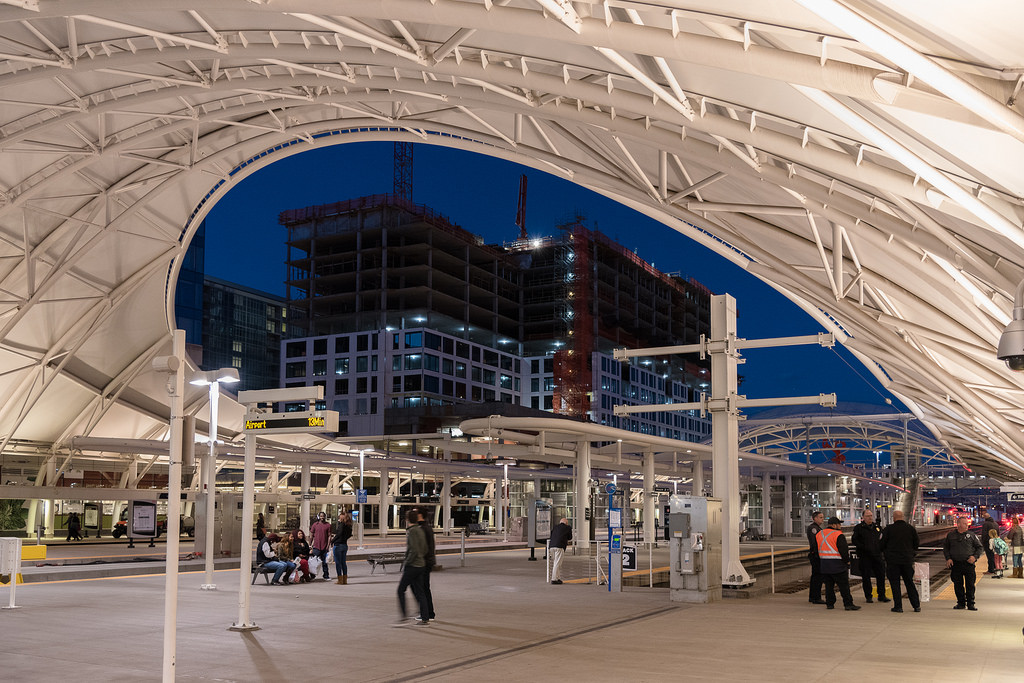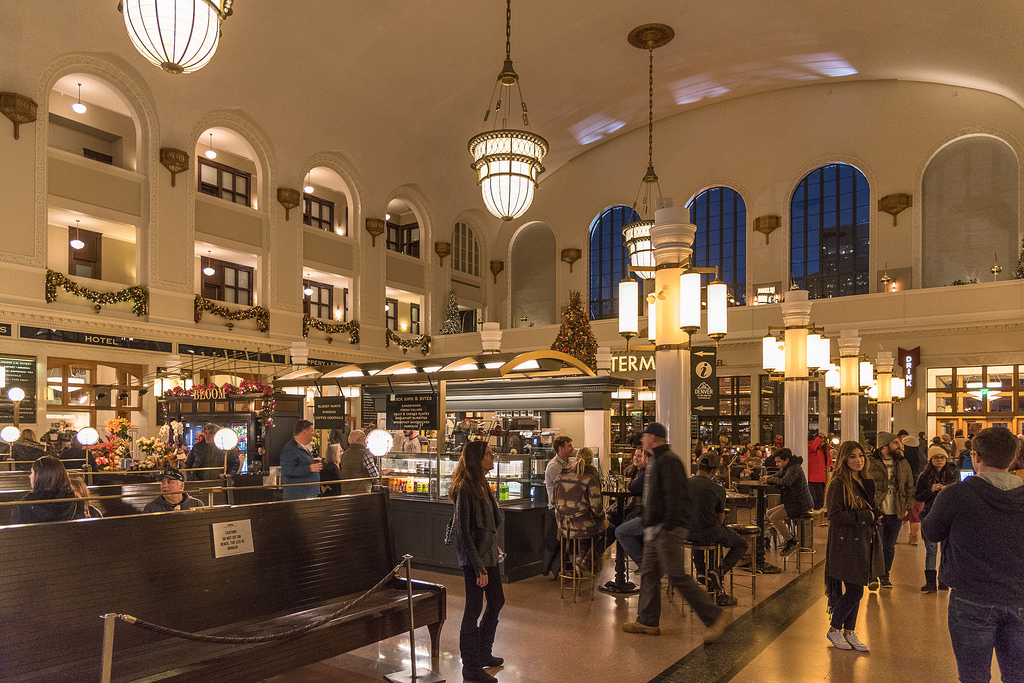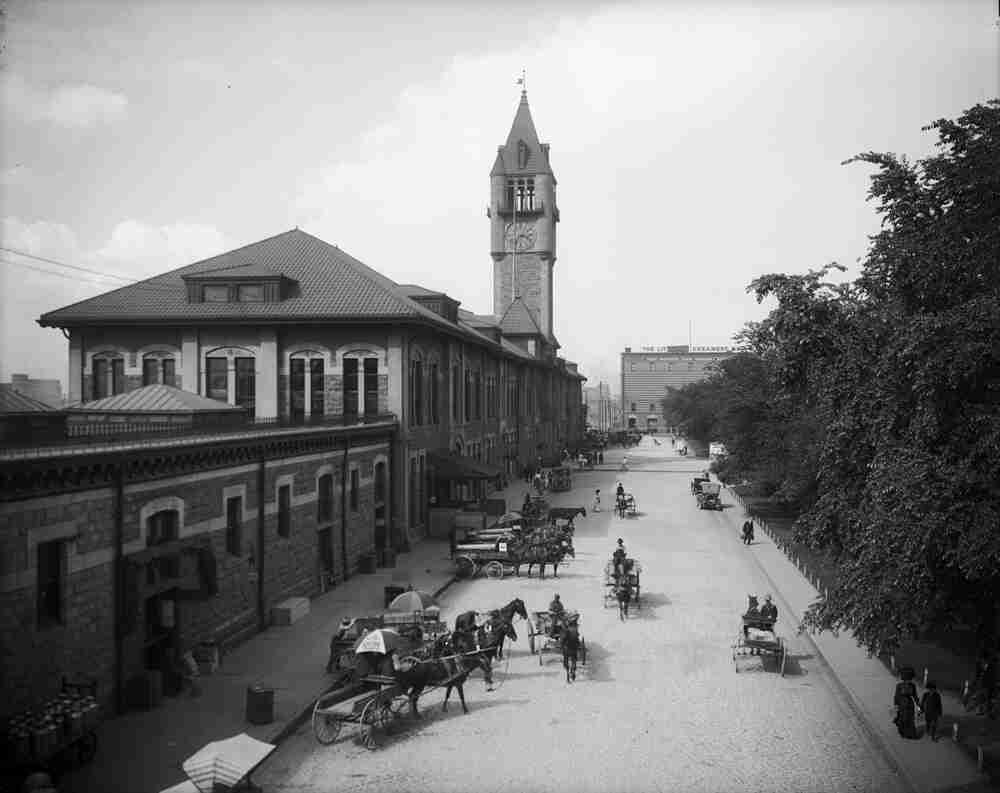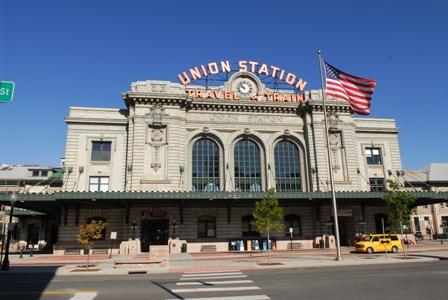Union Station
Full Article
Union Station, located in Lower Downtown Denver (LoDo) on Wynkoop Street between Eighteenth and Sixteenth Streets, is downtown Denver’s main transportation center. It opened in 1881 as the city’s first consolidated railroad depot, and a renovation completed in 2014 reinvented the station as a transportation and visitor attraction.
Development
Although railroads have served Denver since 1868, no consolidated station existed for the city’s rail traffic until the completion of the Union Depot in 1881. The Denver Pacific Railroad (DP) built the first station in 1868 at Wazee and Twenty-first Streets. Three railroads used this station: the DP, which ran north to meet the Union Pacific in Cheyenne, Wyoming; the Kansas-Pacific Railroad (KP), which ran east toward Kansas, and the Colorado Central Railroad (CC), which ran west toward Golden and Central City. In 1871 William Jackson Palmer’s Denver & Rio Grande Railroad (D&RG) built a second station at Nineteenth and Wynkoop Streets because it could not reach the existing depot due to right of way conflicts. The Denver, South Park & Pacific Railroad (DSP&P) built a third station in 1874 at Sixth and Walnut Streets, and the Colorado Central built a fourth station in 1875 at Sixteenth and Delgany Streets.
Momentum gathered for a general use structure in 1879. Jay Gould, controller of most of Colorado’s railroads at the time, suggested the formation of a commission to study the possibility of a joint terminal. Problems had arisen in transferring freight and passengers from one line to another across the dirt paths that connected the various rail stations downtown. Officials of the various railroads and local citizens held a meeting in November of 1879 that resulted in the formation of the Union Depot and Railroad Company (UDR).
UDR directors elected Walter S. Cheesman, a prominent Denver figure, as the first president. Shortly after its creation, the company purchased land at Seventeenth and Wynkoop for the facility. Construction began in 1880, and the depot opened for business in May 1881, with an official grand opening held in July.
Original Union Station
The depot was built in an Italian Romanesque style with stone from several Colorado quarries. The foundation and walls had stones from near Castle Rock, where the D&RG had built a line. The sandstone trim came from a quarry near Morrison, and the DSP&P line freighted it to Denver. The completed structure measured 65 feet by 503 feet, and had a 128-foot tall tower that measured 32 feet square. A lawn fronted the building on the side facing Wynkoop Street. The wings of the building contained baggage and office facilities, and passenger services were in the central portion. At the time of its completion, the structure was one of the largest depots in the American West.
In February 1880, representatives of the four lines that would use the depot signed a contract, which stated that the railroads would pay for use on a percentage basis, depending on the amount of freight and traffic each sent through the station.
On March 18, 1894, an electrical fire destroyed the central portion of the station. Though much of the building burned, the main areas, including the waiting room and baggage area, reopened the following day. Rebuilding commenced immediately. The new tower stood at 168 feet—40 feet taller than the old one. The top of this one contained four clocks, each fourteen feet in diameter.
Twentieth Century Renovations
 In 1906 citizens of Denver dedicated a giant arch in front of the depot. The arch contained 17 tons of metal and 1,600 light bulbs. Originally, the arch read “Welcome” on both sides. In 1908 the Wynkoop Street side was changed to read “Mizpah,” a Hebrew word meaning, “may the Lord watch between you and I while we are apart.” By 1930 the city inspector found the arch to be structurally unsafe and, due to traffic concerns and financial constraints caused by the Great Depression, the city paid to dismantle it.
In 1906 citizens of Denver dedicated a giant arch in front of the depot. The arch contained 17 tons of metal and 1,600 light bulbs. Originally, the arch read “Welcome” on both sides. In 1908 the Wynkoop Street side was changed to read “Mizpah,” a Hebrew word meaning, “may the Lord watch between you and I while we are apart.” By 1930 the city inspector found the arch to be structurally unsafe and, due to traffic concerns and financial constraints caused by the Great Depression, the city paid to dismantle it.
In 1914 the central part of the structure underwent a major renovation that created the Neoclassical front that stands today. A façade reminiscent of Roman arches replaced the clock tower. By 1916 the tracks to the west had been raised five feet, and the addition of passenger tunnels provided easier access to trains. At the same time, mechanical interlocking devices were installed to control the three main tracks which approached the depot, and the installation of umbrella sheds sheltered the tracks during inclement weather.
In August 1932 a $600,000 expansion helped the railroads distribute public mail. Traffic at Union Station increased during World War II, when between sixty and eighty trains arrived and departed every day, and one million passengers used the facility each year. In 1953 the structure underwent a $1 million facelift that thoroughly cleaned the structure. However, with the surge in air and car travel throughout the twentieth century, the use of Union Station steadily decreased. By the mid-1950s rail traffic had declined to nearly half its wartime levels, and the era of the great transcontinental trains came to a close. By 1974 only five trains used the station daily, and that year Denver Union Station was added to the National Register of Historic Places.
Today
 In 2002 the city began planning a major redevelopment of Union Station. The Regional Transportation District (RTD) in Denver, the City and County of Denver, the Colorado Department of Transportation, and the Denver Regional Council of Governments partnered to create a Master Plan to redevelop Union Station. Work began on the redevelopment in 2012 and finished in July of 2014. The new Union Station provides passenger service for Amtrak and RTD buses and light rail. The main building now contains the Crawford Hotel and a number of restaurants and shops for visitors. The revitalization of Union Station came at the same time as the redevelopment of Lower Downtown Denver.
In 2002 the city began planning a major redevelopment of Union Station. The Regional Transportation District (RTD) in Denver, the City and County of Denver, the Colorado Department of Transportation, and the Denver Regional Council of Governments partnered to create a Master Plan to redevelop Union Station. Work began on the redevelopment in 2012 and finished in July of 2014. The new Union Station provides passenger service for Amtrak and RTD buses and light rail. The main building now contains the Crawford Hotel and a number of restaurants and shops for visitors. The revitalization of Union Station came at the same time as the redevelopment of Lower Downtown Denver.
Adapted from Mark E. Stevens, “Union Station,” National Register of Historic Places Nomination form, 1974.



































